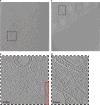Quantifying Variability of Manual Annotation in Cryo-Electron Tomograms
- PMID: 27225525
- PMCID: PMC5111626
- DOI: 10.1017/S1431927616000799
Quantifying Variability of Manual Annotation in Cryo-Electron Tomograms
Abstract
Although acknowledged to be variable and subjective, manual annotation of cryo-electron tomography data is commonly used to answer structural questions and to create a "ground truth" for evaluation of automated segmentation algorithms. Validation of such annotation is lacking, but is critical for understanding the reproducibility of manual annotations. Here, we used voxel-based similarity scores for a variety of specimens, ranging in complexity and segmented by several annotators, to quantify the variation among their annotations. In addition, we have identified procedures for merging annotations to reduce variability, thereby increasing the reliability of manual annotation. Based on our analyses, we find that it is necessary to combine multiple manual annotations to increase the confidence level for answering structural questions. We also make recommendations to guide algorithm development for automated annotation of features of interest.
Keywords: Dice coefficient; annotation; cryo-electron tomography; segmentation; validation.
Figures









Similar articles
-
Evaluation of denoising algorithms for biological electron tomography.J Struct Biol. 2008 Oct;164(1):7-17. doi: 10.1016/j.jsb.2008.04.006. Epub 2008 Apr 22. J Struct Biol. 2008. PMID: 18585059 Free PMC article.
-
MemBrain: A deep learning-aided pipeline for detection of membrane proteins in Cryo-electron tomograms.Comput Methods Programs Biomed. 2022 Sep;224:106990. doi: 10.1016/j.cmpb.2022.106990. Epub 2022 Jul 1. Comput Methods Programs Biomed. 2022. PMID: 35858496
-
A differential structure approach to membrane segmentation in electron tomography.J Struct Biol. 2011 Sep;175(3):372-83. doi: 10.1016/j.jsb.2011.05.010. Epub 2011 May 17. J Struct Biol. 2011. PMID: 21616152
-
Cryo-Electron Tomography and Subtomogram Averaging.Methods Enzymol. 2016;579:329-67. doi: 10.1016/bs.mie.2016.04.014. Epub 2016 Jun 22. Methods Enzymol. 2016. PMID: 27572733 Review.
-
It's noisy out there! A review of denoising techniques in cryo-electron tomography.J Struct Biol. 2021 Dec;213(4):107804. doi: 10.1016/j.jsb.2021.107804. Epub 2021 Oct 31. J Struct Biol. 2021. PMID: 34732363 Review.
Cited by
-
Extracting nanoscale membrane morphology from single-molecule localizations.Biophys J. 2023 Aug 8;122(15):3022-3030. doi: 10.1016/j.bpj.2023.06.010. Epub 2023 Jun 23. Biophys J. 2023. PMID: 37355772 Free PMC article.
-
Volume Segmentation and Analysis of Biological Materials Using SuRVoS (Super-region Volume Segmentation) Workbench.J Vis Exp. 2017 Aug 23;(126):56162. doi: 10.3791/56162. J Vis Exp. 2017. PMID: 28872144 Free PMC article.
-
The advent of structural biology in situ by single particle cryo-electron tomography.Biophys Rep. 2017;3(1):17-35. doi: 10.1007/s41048-017-0040-0. Epub 2017 May 29. Biophys Rep. 2017. PMID: 28781998 Free PMC article.
-
Missing Wedge Completion via Unsupervised Learning with Coordinate Networks.Int J Mol Sci. 2024 May 17;25(10):5473. doi: 10.3390/ijms25105473. Int J Mol Sci. 2024. PMID: 38791508 Free PMC article.
-
Cryo-soft X-ray tomography: using soft X-rays to explore the ultrastructure of whole cells.Emerg Top Life Sci. 2018 Apr 20;2(1):81-92. doi: 10.1042/ETLS20170086. Emerg Top Life Sci. 2018. PMID: 33525785 Free PMC article.
References
-
- Asano S, Fukuda Y, Beck F, Aufderheide A, Förster F, Danev R, Baumeister W. Proteasomes. A molecular census of 26S proteasomes in intact neurons. Science. 2015;347:439–442. - PubMed
-
- Frangakis AS, Förster F. Computational exploration of structural information from cryo-electron tomograms. Curr Opin Struct Biol. 2004;14:325–331. - PubMed
-
- Frangakis AS, Hegerl R. Noise reduction in electron tomographic reconstructions using nonlinear anisotropic diffusion. J Struct Biol. 2001;135:239–250. - PubMed
Publication types
MeSH terms
Grants and funding
LinkOut - more resources
Full Text Sources
Other Literature Sources

